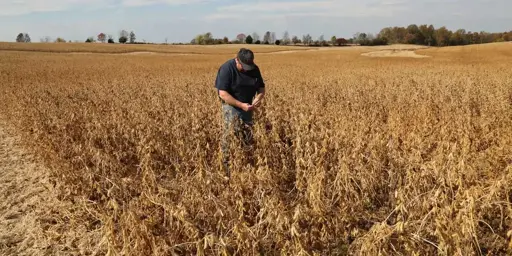spoiler
The tariffs on China could put us out of business by 2027. All our blood, sweat, and toil could vanish with the stroke of a pen.
This week, amid an escalating trade war, President Donald Trump announced a 125 percent tariff on China while the country hit back with an 84 percent tariff of its own. This came as a devastating blow for soybean farmers, because China is their top foreign market. In 2024 alone, more than half of all U.S. soybean exports went to China.
Many soybean farmers have been here before. After Trump imposed tariffs back in 2018 during his first term, U.S. agriculture lost $26 billion—nearly $20 billion in soybeans alone. But Trump also emerged from that first trade war with a deal that many farmers celebrated. In fact, many crop farmers in the American heartland helped reelect him in overwhelming numbers.
Caleb Ragland, 38, from Magnolia, Kentucky, who comes from a long line of farmers stretching back 200 years, is one of them—having voted for Trump in 2016, 2020, and 2024. Still, as the president of the American Soybean Association—representing 500,000 soybean farmers across the country—he is deeply concerned about how tariffs will impact him and his colleagues.
In an urgent plea below, he asks President Trump to secure a deal with China, and save the future of farming in America.
My family has been farmers for nine generations, going back to 1808 when my great-great-great-great-great-great-grandfather cut down trees to build a cabin and barns for livestock, and planted the food they needed to survive.
I can see their gravestones from my home here in Magnolia, Kentucky. My father and grandfather taught me to farm and now I’m paying it forward to my three sons, ages 14, 12, and 9.
In the 1980s, farmers in my area shifted from dairy and tobacco to soybeans as new technology changed the market and made it possible to farm rougher terrain and use pesticides to kill weeds without killing crops. But now, because of the trade war with China, I’m worried we could be out of business by 2027. All that history, heritage, blood, sweat, and toil could vanish with the stroke of a pen.
Soybeans are one of the most versatile crops in the world. They have thousands of uses: They can feed cattle, be turned into biofuel and rubber, and be mined for the seed oils that are used throughout the food industry. Last year, soybeans were the number one row crop in my home state of Kentucky. But as I’m planting seeds this spring, I’m facing fear and uncertainty about who will buy my crops come harvest time in October.
The U.S. became the leader in soybean production about 30 years ago. That’s when China started buying our soybeans as it went through its own industrial transformation, making its people wealthier. With more money to spend, the demand for meat exploded—and so did the need to feed soybeans to poultry, cattle, and pigs in China. To this day, they still use 70 percent of their soybean imports to feed livestock.
Soybean production is a year-round affair. In the spring we prepare the soil, plant seeds, and constantly weed the fields. After fall’s harvest, we put the soybeans on semitrucks and drive them to grain handlers, known as “elevators,” on the river or rail stations. My closest elevator is 100 miles from my house, on the Ohio River. Some of the soybeans are crushed and divided into soybean meal and soybean oil. From there, about half is kept in the U.S. and sold to American buyers; the other half is loaded onto barges and floated down the Mississippi River, where it will be loaded onto ships and sent on a monthslong voyage around the world. Last year, 52 percent of U.S. soybean exports went to China, around a fifth to the European Union, and the rest to other places like Japan, South Korea, and Mexico. Right now, soybeans are around $10 a bushel but just three years ago, they were $17 a bushel.
Some say we should aim to sell all our soybeans domestically. But to do that, we would need to double the markets that we currently have in the U.S. That’s just not going to happen at the snap of a finger. It would mean doubling the U.S. consumption of pork, poultry, and beef as well as biofuel production.
Like many of my fellow farmers, I voted for President Donald Trump in the past three elections. The president won me over with his commitment to business-friendly tax cuts as well as his track record of reducing regulation and cutting government spending.
Back in 2018, President Trump negotiated a trade deal with China that would have been very good for our farmers. We had one problem, though, that derailed its effectiveness: Joe Biden. The Phase One deal went into effect in 2020, but when Trump lost the election, President Biden refused to enforce it.
This afternoon, President Trump announced that he would pause retaliatory tariffs on countries willing to negotiate. To me, this is a sign of the president’s good faith. The 125 percent tariff on China still holds, but Trump’s making it clear: They can still come to the table and walk away with a deal that benefits both countries.
It is urgent that a deal happens. The farm economy is much weaker now than it was in his first term. After the first trade war, we lost nearly 10 percent of market share to China that we never regained. The Biden administration made no effort to enforce the deal’s trade targets or advance U.S. agricultural interests. And rising inflation and the costs of production haven’t helped. We farmers have less working capital and less of a cushion to fall back on these days.
The longer the stalemate continues, the likelier China is to take its business elsewhere—like Brazil, for instance, which could bring an additional 70 million acres of land into agricultural production by cutting down rainforests and converting degraded pastureland. Already, they’re working on this; it may take them only months. If I were a gambler, I’d bet that Brazil could have more land and production faster than we can dramatically increase our domestic demand.
Many American farms are multimillion-dollar businesses. The costs of land, fuel, equipment, storage, labor, and insurance are currently around $600 per acre. That means for a farm with 1,000 acres, it costs $600,000 to put the crop out. Most farmers rely on bank loans for capital. But with increased risk comes increased interest rates.
I am one of the 500,000 soybean farmers in America who feels the pain. I rely on my own farm for 100 percent of the income for my family and the families of our three full-time workers. We have 1,500 acres of soybeans on my farm. At $600 an acre, our production costs are $900,000. But in the current climate, an acre brings in only $500 of revenue, which means we’re yielding $750,000—a $150,000 loss.
This year we’re hoping to hang on with a loan to cover the difference. But not every farmer is so lucky. I’ve watched my fellow farmers, who were already having difficulties, forced to have auctions and sell their farms. Some have had to declare bankruptcy and take whatever work they can get as farmhands.
Most farmers can’t afford any more losses. In the most basic sense, we’re being asked to pay to go to work. That means taking on debt that will take years—and good years at that—to recover from.
This shouldn’t concern only farmers, but all Americans.
The agriculture and food industries support over 34 million American jobs—from seed and fertilizer retailers to agronomists who help farmers make the best financial decisions—and contribute $1.5 trillion to the economy. But it’s also the lifeblood of the American heartland.
As a businessman, President Trump must know how urgent this is. The current trade war with China is a gamble with American livelihoods, especially for farmers—those of us who grew up with soil and sweat—who can’t imagine doing anything else.
Mr. President, I hope you hear our plea: Please make a deal with China now.
Literal soyboys begging for economic DEI lmao.
lmao I think you might have just immortalized yourself in a site tagline
Federation brings its blessings upon us all
 powerful aura, channeling posters past
powerful aura, channeling posters past
Amber.

Some say we should aim to sell all our soybeans domestically. But to do that, we would need to double the markets that we currently have in the U.S. That’s just not going to happen at the snap of a finger. It would mean doubling the U.S. consumption of pork, poultry, and beef as well as biofuel production.
Or you know we could eat the soybeans
 guess after decades of marketing meat as manly they can’t just turn around and go soybeans are cool now. No it’s hip to be a soy boy commercials
guess after decades of marketing meat as manly they can’t just turn around and go soybeans are cool now. No it’s hip to be a soy boy commercialsOr you know we could eat the soybeans
Part of the argument to use soybeans for humans instead of feeding it to cattle is that you need much more soy for a kilogram of beef than what is needed for humans, so if everyone went vegetarian we’d produce way less soy globally. Which means in any case the soy farmers are cooked!
I don’t feel much sympathy either way, honestly food production should be nationalized anyway. The people who do day to day things in these should still be employed but like any top can just go join the job market like the rest of us.
Also tofu is just so fucking good

Went and had a barbecue with my cousins the other day and we made vegan kebab with tofu mushrooms pineapple asparagus and two kinds of squash all marinaded in my aunt’s home recipe. It was so fucking good the tofu came out PERFECT on the grill.
As a fan of natto and most things soy I will gladly buy soy beans from this hog at a 90% discount
Are there “natto boy” t-shirts?
-–
Ninja edit. What the heck. There aren’t if my google image results are accurate.
Well that sucks, we need more bean apparel

I’m really surprised that nobody on the net (Etsy or wherever) - made such a t-shirt. I googled again. This time for “natto girl”. I found a result but it’s got no swagger.

Also - I really hate how “The Great Wave off Kanagawa” is a go-to pop culture reference image for Japanese things.
Also - I really hate how “The Great Wave off Kanagawa” is a go-to pop culture reference image for Japanese things.
Alternate universe where Mitsukuni Defying the Skeleton Spectre Invoked by Princess Takiyasha is the go-to pop culture reference for old Japanese things
Alternate universe where Mitsukuni Defying the Skeleton Spectre Invoked by Princess Takiyasha
Hell yeah. I didn’t know the name but I was pretty sure I knew what you were talking about. And I was right.
Ngl I love the waves and the different interpretations I’ve seen of it but yeah it’s kinda close to Godzilla and Pikachu in the “common tier pop reference” shtick.
Ngl I love the waves and the different interpretations
It certainly does really inspire people.

Woodburned Great Wave off Kanagawa. The whole guitar has a strong Japanese feel.
Considering the artist is a rando redditor - they did a fantastic job.
these were the exact bozos that used to tell people like me that we were bullshit/crazy. we would research global systems, climate science, political economy and come back with “we need to diversity our agricultural systems. we must transition and rely less on monocropping for export markets. we need more institutional support for diversification.”
and they would crow about how they were the big dogs, because they planted thousands of acres, they got preferential treatment at the credit providers, and the banks all backed them with whatever loans they needed. they didn’t need any other information or perspective except the checks they got from the elevator. they didn’t care that this same model of plantation-export has been used on colonized countries to extract and underdevelop. we’re America, we’re different.
they heard a million different ways from everybody that they were pursuing short term returns and over leveraging the resources they depended on to set up one of the most fragile systems in agricultural history.
it must absolutely sting extra sharp that it was their boy Trump–king of the rural red states and high priest of their bourgeoise planting class–who decided to roundhouse them right in the fucking balls.
somebody should email this asshole and say, “Obama never would have done this.” twist that knife.
none of this is good news btw. the folding farms will transfer to larger and larger landholders who will increasingly insist on pursuing the same systems of booms/busts because they fit the logic of capital: limited labor, seasonal, easily relocated/dismissed.
the future of the US Midwest are the Brazilian mega farms like in Mato Grosso, 30,000-50,000 acres a pop, 750-1000 employees all replaceable, mostly transient while the owners and shareholders live in penthouses and negotiate licensing deals with tarrifs exemptions.
a moonscape of fields you can’t see the edge of due to the curvature of the earth, and absolutely no sign of anything that ever existed before.
Good post, say what you want about yeoman farmers but I don’t even consider these assholes farmers just a different kind of landlord parasite
He doesn’t even have an agronomy degree:
Ragland is a graduate of Bryan College with a B.S. in Business Management and Economics/Finance, Summa Cum Laude.
Lol what a sucker

The farm economy is much weaker now than it was in his first term. After the first trade war, we lost nearly 10 percent of market share to China that we never regained.
Shit, its almost like you pissed them off with the first trade war and they decided to stop buying from you
Enjoy the trade war
“Maybe the stove won’t be hot when I touch it this time”
I swear to God I read this headline during Trump round 1
Soybean Farmers sowing


Soybean Farmers reaping




Soy the wind - reap the whirlwind.

Soybean farmer forgets 2016 Trump trade war that almost bankrupted him somehow, I guess
When Trump renegotiated that during that time they didn’t need the soybeans they were importing. They imported the amount they did to appease the deal. Now the deal is off. So they have gone to other countries to get what they need and aren’t coming back. They will not be importing any more soybeans from the USA no matter what happens from here on out. China got played once. Never again.
China also imports an absolute load of Beef from Argentina. Huawei literally sells phones there and trades them in beef. Huawei, a cell phone manufacturer, is China’s largest beef importer because of this. And that is because the USA fucked around with Huawei and other previous trade-war shit. Funny how that works.
It’s in the article lol. They remembered the first term, but then thanked him for the deal he made afterwards.


 Go bankrupt so that I can buy your land at a discount and regenerate it.
Go bankrupt so that I can buy your land at a discount and regenerate it.Hahaha get fucked dipshit, real “oh no ‘flesh flayer 2000’ is flaying my flesh! how could this happen!? I didn’t want my flesh flayed only others!”
Wow how about making a better product instead of wanting government handouts.
Soy 2.0, now with corn
high fructose soybean syrup
Its what vat-beef craves!

Literally

Mr President, I’m a chadbean farmer from, uh, the american south, keep on the Trade War sir, don’t listen to Panicans, muito brigado.
kulak can’t see beyond his navel
lol death to the landed gentry





















